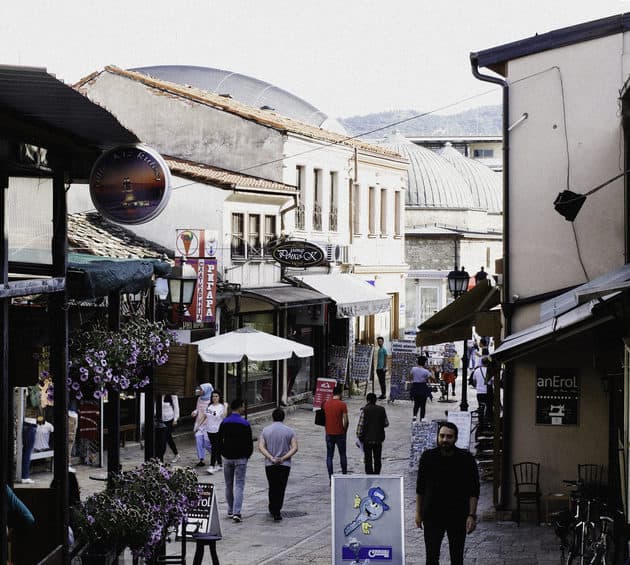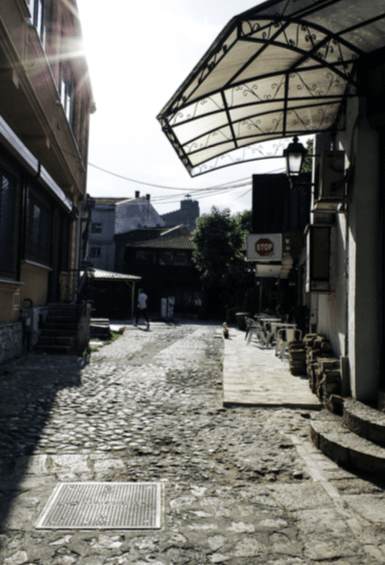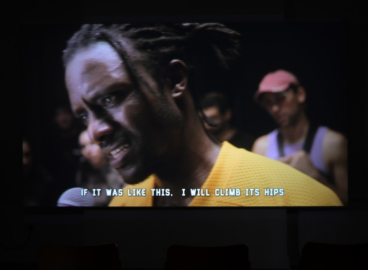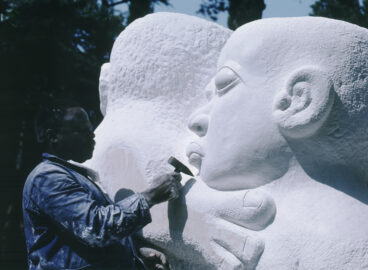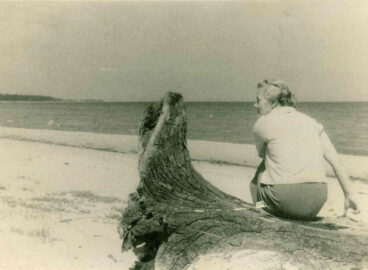The history of the reconstruction of the Macedonian capital Skopje, after a devastating earthquake in 1963, is at this point firmly associated with the role played by the Japanese architect Kenzo Tange and his Brutalist contributions to the cityscape. But Maja Babić turns her attention to the Ottoman heritage of the city, which she argues was largely disregarded in Skopje’s efforts to assert its “political modernization,” intended to bring the capital in line with other major cities of the former Yugoslavia but which neglected urban spaces associated with an Albanian Muslim minority.

The current exhibition on Yugoslav architecture at The Museum of Modern Art,Toward a Concrete Utopia: Architecture in Yugoslavia, 1948–1980, opens a window into the complex architectural history of the former Yugoslavia. The exhibition introduces North American audiences to some of the particularities of the buildings designed and constructed in a socialist country during the Cold War and looks at the intricacies of production, not only of architecture, but also of culture and identity.
Here, I examine one striking moment in the fifty-year-long Yugoslav history: the reconstruction of Skopje in the aftermath of the 1963 earthquake, a remarkable event that functions as a unique example of the nuances in the creation of Yugoslav cities, and the cities’ unavoidable connection to ideology, and the related negotiation of national, local, political, cultural, and social identities.
At the beginning of the twentieth century, as the Ottoman Empire ceased to exist, its demise left the Balkans in disarray. In 1918 Macedonia became a part of the Kingdom of Serbs, Croats, and Slovenes. Architecturally, the interwar period in Macedonia, as elsewhere in the Kingdom, was marked by a nascent modernism, executed almost exclusively by architects from Belgrade, Zagreb, and Ljubljana. Architects educated in the studios of erstwhile modernists such as Otto Wagner and Le Corbusier and at the Bauhaus now utilized their acquired knowledge in the cities of the new Kingdom, creating a built environment for the modern age. An interwar modernity characterized by works of modernist architecture gradually emerged in Skopje, the capital of Macedonia, and introduced the proverbial East to West in what was a synthesis of the heritage remaining in the aftermath of the centuries of Ottoman rule and the modernist architecture of Western Europe. Ottoman heritage was preserved to an extent as the Kingdom’s architects “destroyed and rebuilt conspicuous part [sic] of Skopje” in an attempt to create a national architectural style.1Fabio Mattioli, “Unchanging Boundaries: The Reconstruction of Skopje and the Politics of Heritage,”International Journal of Heritage Studies 20, no. 6 (2014): 604. In the calamity to come, during World War II, the old Skopje, which includes the Ottoman Bazaar, remained remarkably unharmed,2Goran Janev, “‘Skopje 2014’: Erasing Memories, Building History,” in Balkan Heritages: Negotiating History and Culture, eds. Maria Couroucli and Tchavdar Marinov (Surrey, England; Burlington, VT: Ashgate, 2015), 123. emerging in the early postwar years as an important element in the negotiations of Skopje’s urban and national fabric. In 1945, as the war ended in Europe, the Yugoslav federation was formed. Macedonia, one of the country’s six republics, embraced the quest for modernity that inevitably created the political and economic environment in which the architectural reemergence of modernism was imminent.


In the aftermath of World War II, the severely torn country embarked on the project of reconstruction, and on a course of rampant modernization that facilitated the modernist architectural production. A narrative present within the scholarly works on Yugoslav architecture unanimously concedes that the architecture in the country at this time was not Yugoslav architecture, but rather the architecture of Yugoslavia. The attempts to construct a national architectural identity had been promptly abandoned after the early Yugoslav period. Only swayed toward Socialist Realism during the young federation’s first three years, during its amicable and thoroughly permeating diplomatic relations with the Soviet Union, Yugoslav architects, planners, and politicians espoused the tenets of modernist architecture in their considerations of the federation’s urban identity.3Socialist Realism in architecture was mainly employed in the Soviet Union and other Eastern Bloc countries. An architectural style envisioned to promote and glorify the virtues of communism, it mainly employed exaggerated scale and Neoclassical and folkloric precedents, with a particular focus on technological developments. Socialist Realist architecture was intended to educate the (urban) population about the tenets of communism and simultaneously to create a backdrop for parades and marches. This architectural style was employed in Yugoslavia in a short three-year period between 1945 and 1948, during the amicable relations between Tito and Stalin, and was promptly abandoned after the 1948 Tito-Stalin clash. Only one building was ever completed in the Socialist Realism style in Yugoslavia: the Trade Union Building in Belgrade. However, in accordance with the perceptions of federalism staunchly promoted by the Yugoslav government, the notions of national identity and the republics’ individual local identities remained removed from the notions of Yugoslav national architecture. The national architectural style was only loosely defined and implemented in the republics, allowing for local iterations. As Vladimir Kulić and Maroje Mrduljaš pointedly state, “Nation-based architectural cultures were related to, but ultimately distinct from the question of the representation of national identities.”4Maroje Mrduljaš and Vladimir Kulić, Modernism In-Between: The Mediatory Architectures of Socialist Yugoslavia(Berlin: Jovis, 2012), 77. The architectural identities of the Yugoslav republics were mainly rooted in local histories and created under the guidance of local and national modernist architects. Notably, in Macedonia, the nationality of whose peoples was only recognized in 1945, the “articulation of the national identity played an important role in the construction of Skopje as a capital.”5Ibid., 78.
As was the case throughout the country, the burdens of the past played a significant role in the creation of the Macedonian republic. In Skopje, this legacy was exhibited in the political and urban relations between Macedonians (mainly descended from the Slavic tribes that moved into the region between the 6th and 8th centuries CE) and the minority Muslim Albanians (most of whom trace their descent to the ancient Illyrians). The modernist architecture slowly permeating the city signified the inevitable shift taking place—both politically and architecturally— and the new urban identity of the Macedonian capital gradually grew less historic in spirit (and less Ottoman for that matter) and more Yugoslav. Architectural modernism and Kenzo Tange’s 1965 Brutalist proposal for the Skopje city center signified the architectural production of a Yugoslav public space, one characterized by the national quest for modernity—albeit a modernity that discriminated against not only minorities but also the architectural expressions of their past. The Brutalist architecture of Skopje was arguably intended to unify the local Macedonian identity with the broader Yugoslav one, and yet its persistent exclusion of non-Macedonian heritage inevitably rendered the urban fabric of the city fragmented. The rise of Brutalism in Skopje parallels architectural development throughout the country, yet the modernist treatment of Ottoman heritage in Macedonia is unique by comparison.





Although the ever-present narrative of “brotherhood and unity” pervaded the political and architectural public space, the reality was not as simple as Yugoslav communist politicians argued. Though minorities were guaranteed all rights by the constitution, when examined in some depth, the urban environment reveals a different story. The cultural anthropologist Fabio Mattioli argues that “Skopje’s Ottoman heritage”—inherently the Muslim Albanian urban space—“has been excluded” from the city’s built environment through the local government’s decades-long political and architectural process of “marginalization and erasure of Ottoman urban spaces.”6Fabio Mattioli, “Unchanging Boundaries: The Reconstruction of Skopje and the Politics of Heritage,” 600. The urban change that slowly transformed Skopje embraced the historic Macedonian segments of the city but did not incorporate Ottoman heritage in a meaningful way, instead assigning it a diminutive role as a token historical element within the multiethnic and multinational Yugoslavia, and its republics’ rich pasts.
As the city crumbled in July 1963, recovery and reconstruction commenced almost immediately. National and international aid poured into the city, and soon, Skopje was a focus of international politics, as well as open to urban and national transformation. The widely lauded United Nations’ competition for the reconstruction of the city center was held, naming the internationally acclaimed architect Kenzo Tange and the Croatian duo of Wenzler and Miščević as the winners, and a Brutalist Skopje was born.7Kenzo Tange and the Croatian duo Miščević and Wenzler were awarded the first prize (60 percent and 40 percent respectively), and in the aftermath of the competition, an international group—including the winners and participants in the competition—was formed with the purpose of designing the city center. Although archival documentation of the competition emphasizes the preservation of Ottoman heritage, Tange’s city center proposal did so only marginally, and the Ottoman Bazaar had been reconstructed not only by its owners, but merely to “look [. . .] ‘traditional.’”8Fabio Mattioli, “Unchanging Boundaries: The Reconstruction of Skopje and the Politics of Heritage,” 609. In fact, traditional Ottoman design principles were only followed on the Bazaar’s facades; its interior reconstruction was arbitrary.

Elsewhere in Yugoslavia, Juraj Neidhardt’s 1955 design for the People’s Assembly of Bosnia and Herzegovina in Sarajevo evoked the “traditional Ottoman domes,” and was considered as an “architectural summary of traditional Bosnian identity.”9Vladimir Kulić, “Architecture and Ideology in Socialist Yugoslavia,” in Unfinished Modernizations: BetweenUtopia and Pragmatism, eds. Maroje Mrduljaš and Vladimir Kulić (Zagreb: UHA/CCA, 2012), 60. Andrija Mutnjaković’s 1971 design for the National and University Library of Kosovo in Priština also utilized domes, a “common denominator of Byzantine and Ottoman heritage,” and showed the “multiple ethnic and religious identities of Kosovo.”10Ibid., 63. Unlike in Sarajevo and Priština, in Skopje, Ottoman heritage was omitted in the creation of the new city, and the historical motifs—if any—refer only to vernacular Macedonian heritage and national identity.11Vladimir Kulić, “Architecture and Ideology in Socialist Yugoslavia,” 62.



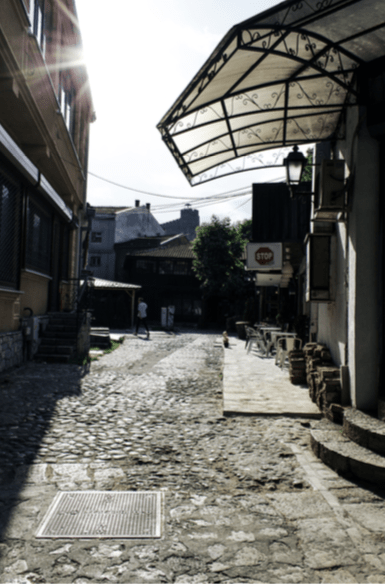
Why was the architectural incorporation of Ottoman heritage employed in Sarajevo and Priština not paralleled in Skopje? The flawed notion of Skopje as a tabula rasafit for Brutalist experimentation and political modernization played a significant role, and yet the ethnicities of the citizens of Skopje factored in as well. The treatment of Turkish and Albanian Muslims in Skopje, unlike that of the Slavic-speaking Muslims in Bosnia, tells a different story, one that suggests a lack of acceptance. Unlike the Bazaar in Sarajevo, a cherished historical urban center, the reconstructed Ottoman Bazaar in Skopje reveals the “secular divisions of the city between old and new,” and serves as a “product and the producing environment for systems of [. . .] classifications.”12Fabio Mattioli, “Unchanging Boundaries: The Reconstruction of Skopje and the Politics of Heritage,” 612.



Today, statues of Alexander the Great and Philip II of Macedon face each other in Macedonia Square, Skopje’s main square. The array of new architecture has been constructed in a generic Neoclassical style. Tange’s City Wall apartment blocks is now located behind advertising billboards. The modernist Macedonian Opera and Theater stands in the shadow of a Neoclassical colonnade lined with figures of great Macedonians from the past—and of those not necessarily Macedonian at all. The Ottoman Bazaar exists in odd seclusion. It is a prized element of heritage and a tourist attraction, yet visitors are warned not to go there after nightfall. The “Europization” of Skopje is becoming intertwined with urban displays of Albanian ethnic motifs, as the “facade nationalism”13Goran Janev, “‘Skopje 2014’: Erasing Memories, Building History,” 119. of Macedonians is juxtaposed with the Ottoman and Muslim Skopje.

- 1Fabio Mattioli, “Unchanging Boundaries: The Reconstruction of Skopje and the Politics of Heritage,”International Journal of Heritage Studies 20, no. 6 (2014): 604.
- 2Goran Janev, “‘Skopje 2014’: Erasing Memories, Building History,” in Balkan Heritages: Negotiating History and Culture, eds. Maria Couroucli and Tchavdar Marinov (Surrey, England; Burlington, VT: Ashgate, 2015), 123.
- 3Socialist Realism in architecture was mainly employed in the Soviet Union and other Eastern Bloc countries. An architectural style envisioned to promote and glorify the virtues of communism, it mainly employed exaggerated scale and Neoclassical and folkloric precedents, with a particular focus on technological developments. Socialist Realist architecture was intended to educate the (urban) population about the tenets of communism and simultaneously to create a backdrop for parades and marches. This architectural style was employed in Yugoslavia in a short three-year period between 1945 and 1948, during the amicable relations between Tito and Stalin, and was promptly abandoned after the 1948 Tito-Stalin clash. Only one building was ever completed in the Socialist Realism style in Yugoslavia: the Trade Union Building in Belgrade.
- 4Maroje Mrduljaš and Vladimir Kulić, Modernism In-Between: The Mediatory Architectures of Socialist Yugoslavia(Berlin: Jovis, 2012), 77.
- 5Ibid., 78.
- 6Fabio Mattioli, “Unchanging Boundaries: The Reconstruction of Skopje and the Politics of Heritage,” 600.
- 7Kenzo Tange and the Croatian duo Miščević and Wenzler were awarded the first prize (60 percent and 40 percent respectively), and in the aftermath of the competition, an international group—including the winners and participants in the competition—was formed with the purpose of designing the city center.
- 8Fabio Mattioli, “Unchanging Boundaries: The Reconstruction of Skopje and the Politics of Heritage,” 609.
- 9Vladimir Kulić, “Architecture and Ideology in Socialist Yugoslavia,” in Unfinished Modernizations: BetweenUtopia and Pragmatism, eds. Maroje Mrduljaš and Vladimir Kulić (Zagreb: UHA/CCA, 2012), 60.
- 10Ibid., 63.
- 11Vladimir Kulić, “Architecture and Ideology in Socialist Yugoslavia,” 62.
- 12Fabio Mattioli, “Unchanging Boundaries: The Reconstruction of Skopje and the Politics of Heritage,” 612.
- 13Goran Janev, “‘Skopje 2014’: Erasing Memories, Building History,” 119.
